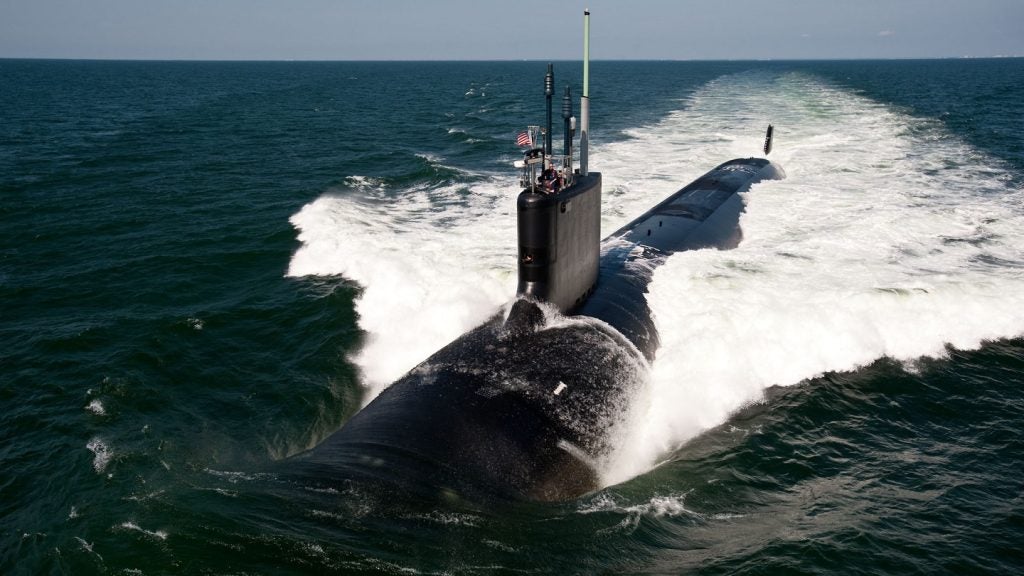The joint US-UK-Australian AUKUS programme has been thrust back into the spotlight in Washington, DC, in recent days, with a series of announcements related to submarine industrial capacity and senior diplomatic visits keeping the subsurface domain at the forefront of Western defence minds.
In addition to other areas where the US is supplying Australia with defence equipment – a relationship that goes back decades with platforms such as the F/A-18 Super Hornet fighters, MQ-4C Triton drones, or Boeing P-8A Poseidon maritime patrol aircraft – AUKUS has been the centre of discussion between US and Australian officials in Washington in recent days.
US President Joe Biden hosted Australian Prime Minister Anthony Albanese in late-October, a meeting that while also signed off on a number of industry deals, also reiterated a commitment to “fully implement the AUKUS partnership”, according to a senior White House official speaking on 24 October.
On 31 October, US Secretary of Defense Lloyd Austin met with his Australian counterpart Richard Marles, with Austin calling 2023 a “historic year” for the “unbreakable alliance” between the two countries.
“We're investing in each other whether through US support for Australia's guided weapons and explosive ordinance enterprise or by working together on AUKUS,” Austin said during a joint briefing with Marles.
For his part, Marles extoled Australian ties with the US, praising Canberra’s planned acquisition of a nuclear-powered submarine capability “through the help of both the United States and the United Kingdom” under the banner of AUKUS.
“This is a really important visit in terms of progressing that there's much to talk about in terms of the detail of that. But we're also acutely aware that legislation which will underpin that is making its way through the Congress as we speak,” Marles said.

The same day, the US Department of Defense (DoD) had issued an urgent supplementary budget request to the US Senate for more $58bn, of which $3.3bn was specifically earmarked “to meet US military requirements in our submarine industrial base and to fulfill our AUKUS commitments”, stated a DoD official.
US submarine industrial base analysis
Some days earlier, on 25 October, US Representative Trent Kelly (R-MS), Chairman of the Subcommittee on Seapower and Projection Forces, stated during a hearing on US submarine industrial base capability to meet the strategic objectives of the AUKUS partnership that the programme would “serve as a critical tool for continued deterrence against the People’s Republic of China”.
Continuing, Kelly said the US submarine industrial base had “been challenged” in recent years, with labour and supply chain issues, and two years of Covid-19 restrictions had “strained” its ability to construct two Virginia-class nuclear attack submarines (SSN) and one Columbia-class ballistic missile submarine per year as planned.
In addition, Kelly said that another issue was the US submarine maintenance backlog, which was “reducing the number of operationally ready SSNs to meet day-to-day mission demands”.
It was reported in July that US Navy (USN) had 31 of 49 SSNs available for operations in FY2023, with the 18 remaining vessels either in maintenance or idle awaiting their turn in a shipyard.
In order to “course correct”, the US Navy spent $2.3bn from FY18-FY23 to build and strengthen Submarine Industrial Base capacity. Moving forward, the Biden administration initiated an additional five-year, $2.4bn investment, Kelly stated, adding that it was “critical” to secure an Australian pledge of $3bn additional funding to assist US infrastructure challenges.
“This subcommittee worked to add several measures in the [House Armed Services Committee]-passed [National Defense Authorisation Act] to support the AUKUS framework and our industrial base, including additional… money and authorisation of up to 13 attack submarines over the next multi-year contract,” Kelly said.
AUKUS trilateral relationship already engaged
Joint US-UK teams have also engaged in visits to Australia to help determine how best to assist Canberra in establishing the necessary nuclear infrastructure needed to operate and maintain SSNs. A 14 September release from UK defence prime Babcock stated that the company, along with US shipbuilder HII, had sent a team to Australia to “support goals of the AUKUS agenda”.
When fully operational, the HMAS Stirling naval base in Australia will host and support the deployment of one Royal Navy Astute-class SSN and four US Navy Virginia-class submarines, by the start of 2027.
In a workup programme before being able to fully accommodate forward-deployed US and UK assets, there will be an increase in visit of submarines from the US in 2023, followed by the UK from 2026. From 2027, rotations of UK and US submarines to Australia will commence.
Pillar 1 of the AUKUS framework culminates with the sale of Virginia-class submarines to Australia in the early 2030s, with the Royal Australian Navy operating up to three Virginia-class SSNs, which are likely to be in service for at least 10 years, and a further two Virginia class being held on option.
Likely in service for at least ten years, Australia will replace the Virginia-class submarines with the SSN-AUKUS design, a joint programme with the UK that will deliver a next-generation SSN to replace the Astute and Virginia classes in service.
The UK will deliver its own first SSN-AUKUS in the late 2030s, with the first SSN-AUKUS built in Australia delivered forecast for the early 2040s. The SSN-AUKUS design is an evolution of the UK’s own SSNR (Submersible Ship Nuclear Replacement) concept intended to replace the existing Astute class.









